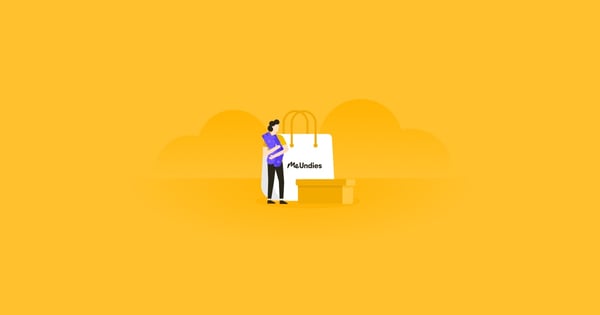Eight years ago, Jonathan Shokrian found himself running around a department store.
What was supposed to be a quick trip to buy affordable and comfortable underwear, turned into a long and frustrating experience—but it sparked an idea:
He would launch a direct-to-consumer underwear brand.
Today, that brand is MeUndies: one of the fastest-growing online apparel retailers. Promising, “The World’s Most Comfortable Underwear,” MeUndies has grown 1,583% in the last three years, alone, with an estimated annual revenue of $60M. (Sources here, here and here.)
I recently spent a month reverse-engineering MeUndies’s marketing strategy. And today, I’ll share 9 actionable strategies you can use to get more traffic and higher conversions for your online store…
…even if you don’t have much traffic (or a big marketing budget).
Take a Peek Inside MeUndies’s Marketing Toolkit
1. Turn Visitors into Buyers with a Homepage Quiz
2. Create an Ascension Ladder to Increase Retention
3. Build a Replicable Referral Engine (With a Twist)
5. Leverage The Power of Podcasts
6. Use The Best-Of Backlink Builder
7. Activate New Subscribers with Small Wins
MeUndies Marketing: What You Need to Know
If you’re a regular reader of our growth guides, you know we usually go through a brand’s entire marketing funnel, from top to bottom.
But given 47.46% of MeUndies’s traffic is direct…
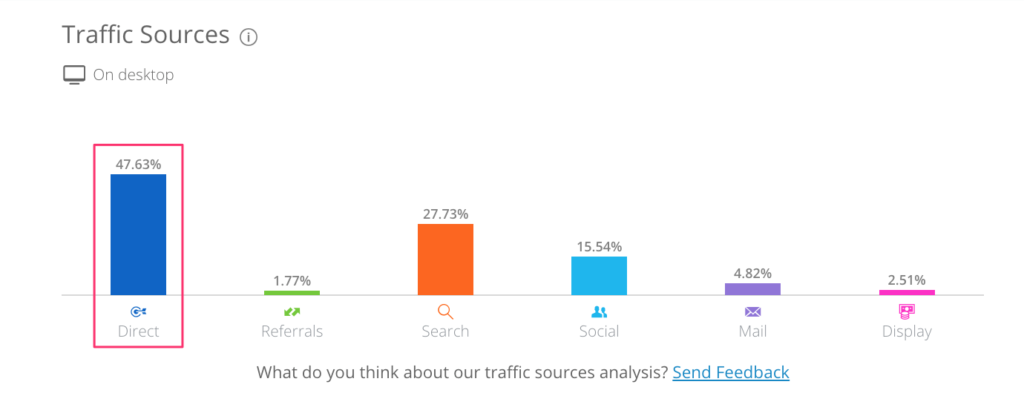
…and only 27.73 is organic…
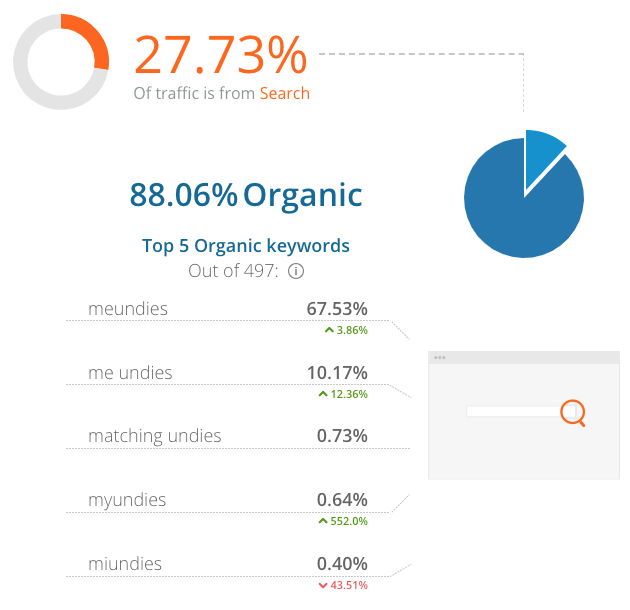
…I decided to focus on what they’re doing to convert BRAND-AWARE visitors into buyers.
So, with that in mind, let’s get into MeUndies marketing, starting with…
1. Turn Visitors into Buyers with a Homepage Quiz
Much like Beardbrand, MeUndies use a homepage quiz to turn first-time visitors into buyers. (The emphasis, here, is on “first-time.” More on that in a moment.)
Here’s how it works.
When you visit MeUndies’ homepage for the first time, you’re invited to “find your first pair” of underwear:
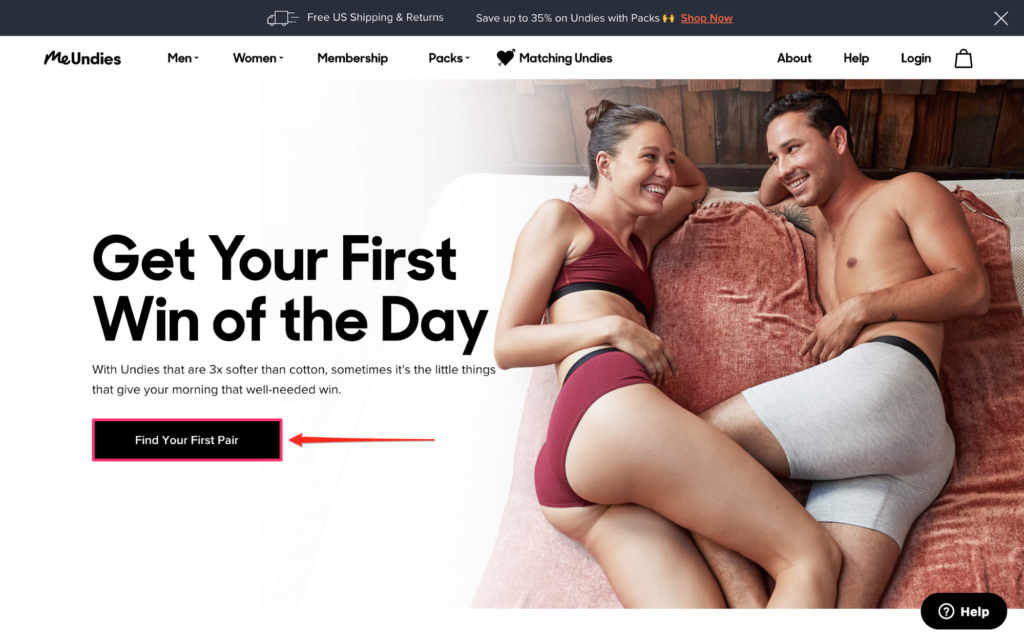
When you click the call-to-action button, MeUndies survey you on your preferences.
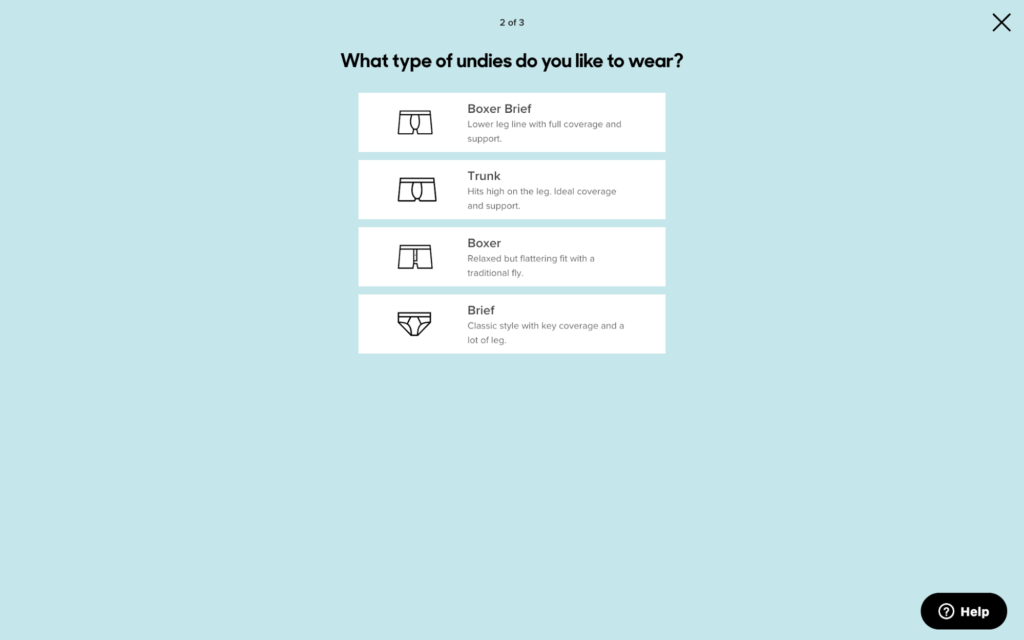
After you choose which type of underwear you like to wear, they ask you to choose a color:
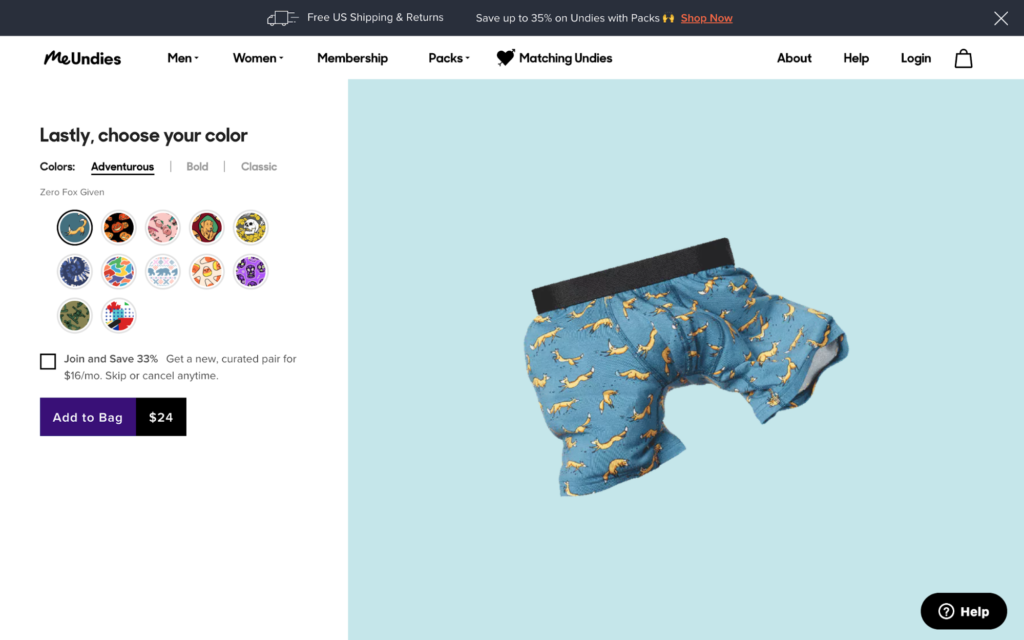
But there are a few things going on here.
First, “Adventurous” is the default color. Meaning, it’s the first color you see after answering the above questions. But it’s also their most expensive. For comparison, an Adventurous pair is $24, but a Bold or Classic pair is $20.
Second, there’s a subtle upsell to their membership. I’ll write more about this in Strategy #2, but for now, notice the emphasis on:
- Savings. (“Join and save 33%”);
- Risk-reversal. (“Skip or cancel anytime”); and
- Simplicity. (Check).
After completing the quiz, I bought a pair of undies. (You know, for research.) But when I returned to their homepage after, I noticed something interesting…
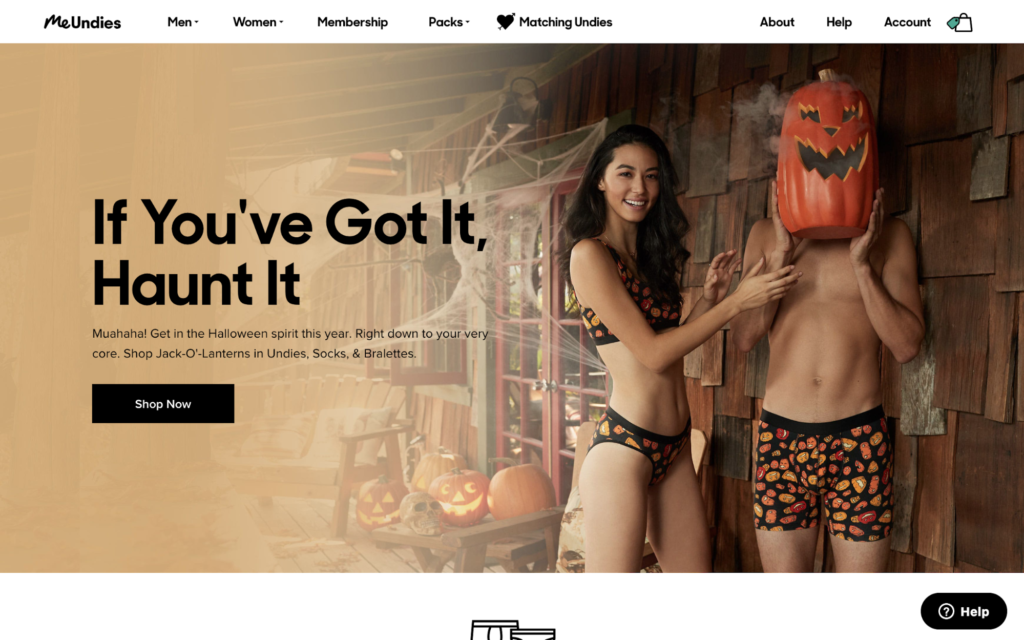
They changed their hero image.
And it makes perfect sense.
No one, after all, wants to see a quiz they’ve already taken. The purpose was fulfilled; it’s time to invite users to take another action.
Speaking of which, there’s something else going on with MeUndies’s above-the-fold content, but we’ll return to it in Strategy #4…
Action item. Use a homepage quiz to help first-time visitors find the right product for them. Then, exclude from return visitors and customers.
2. Create an Ascension Ladder to Increase Retention
There are many ways to improve customer retention.
Reward brand advocates. Personalize your emails. Use reciprocity.
But there’s one way that’s more powerful than any other…
Creating a hierarchy, or an ascension ladder, ideally, through membership.
“When you figure out how to structure your business with ‘membership concept’ and then levels, so customers can move from one level upward to the next, and then to the next, you will have constructed a way to automatically improve retention,” writes Dan Kennedy in No B.S. Guide to Maximum Referrals. “As their level of commitment increases, their longevity automatically increases.”
MeUndies get the power of taking their customers and “moving ‘em up the money pyramid.” So much so, that they recently moved to a membership model to grow their business faster.
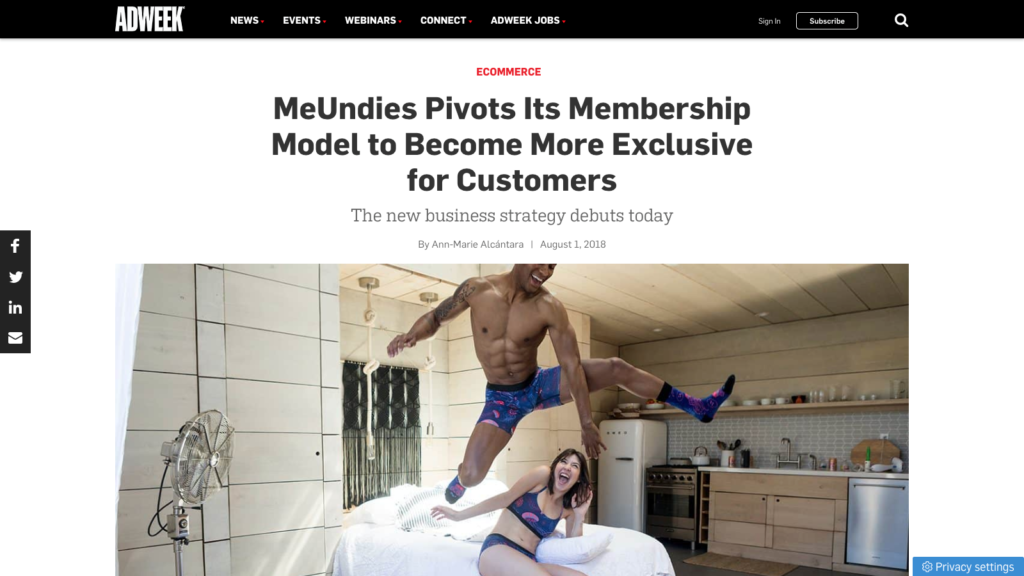
But it’s not that membership that’s worth noting here, it’s how they’re selling it.
Take their product pages, for example. On it, there are several chances to upgrade a one-time purchase to a membership:
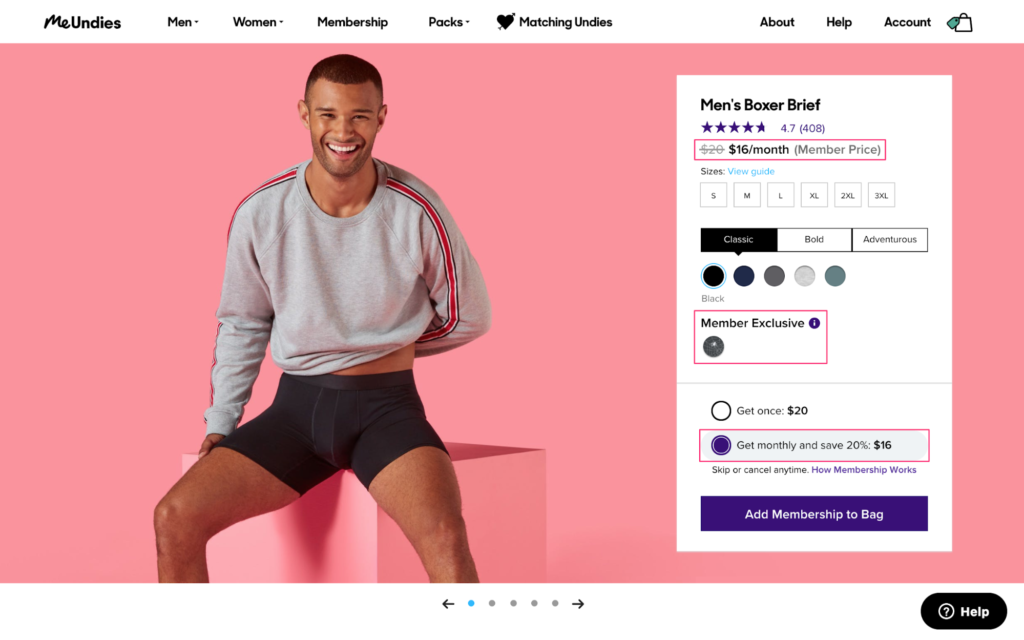
First, they emphasize how much you save with a membership versus a one-off purchase:
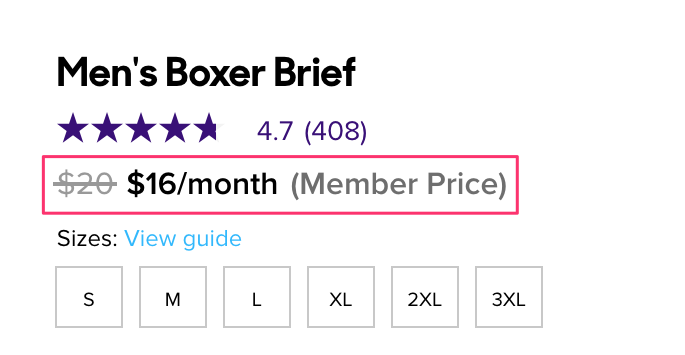
Second, they offer “Member’s Exclusive” prints (more on that in a moment):
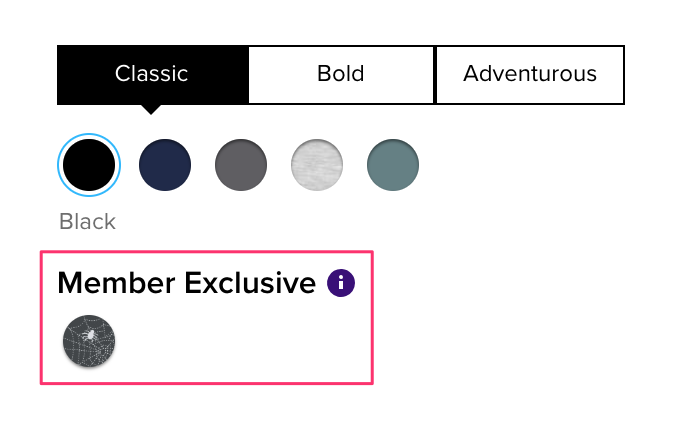
Third, they remind you again of how much you save with a membership before reversing risk with an unbeatable guarantee.
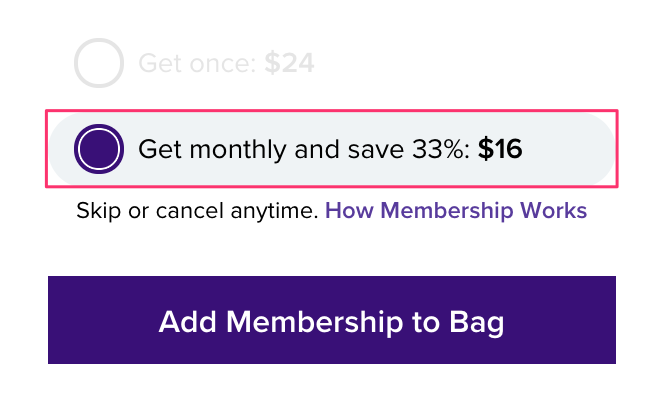
Fourth, there’s a final reminder to upgrade when you reach checkout:

MeUndies’ membership exclusivity isn’t just promoted on their site. It’s also prominent in their Facebook ads…
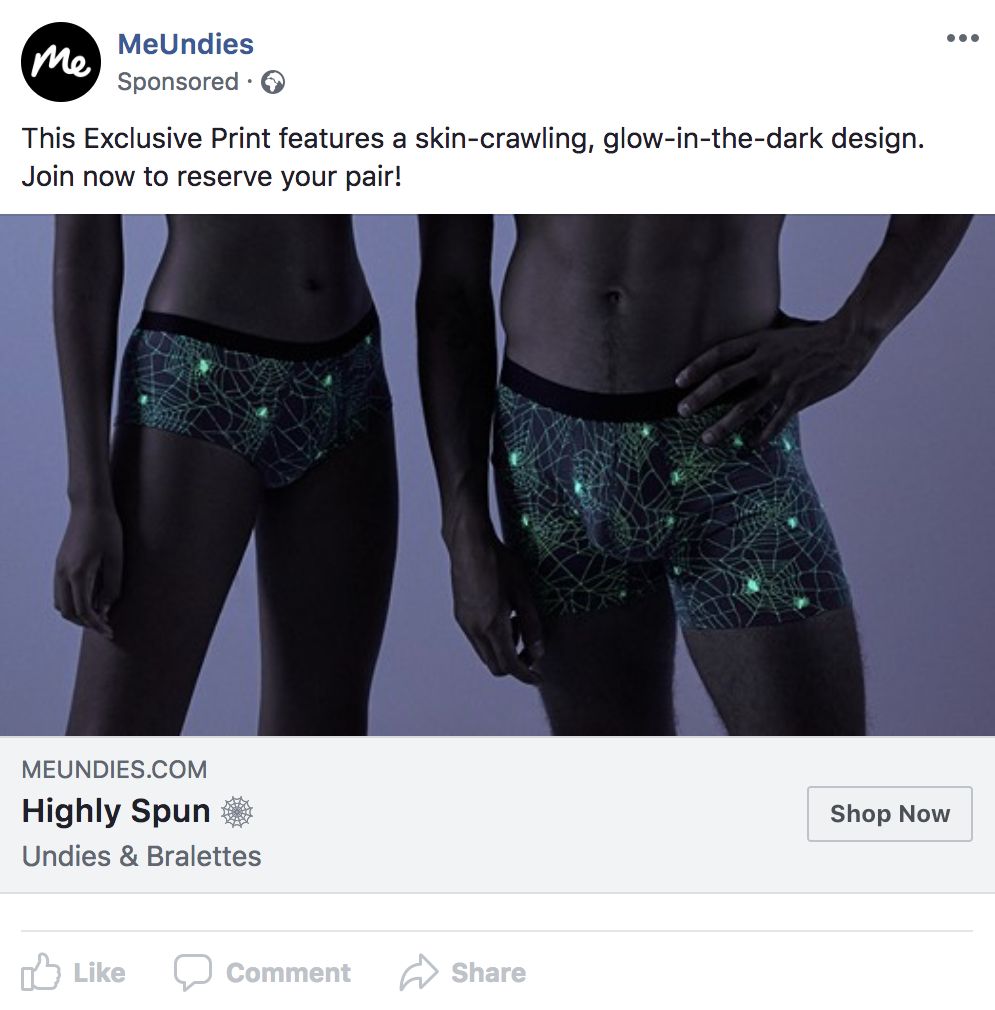

…and in their onboarding emails:
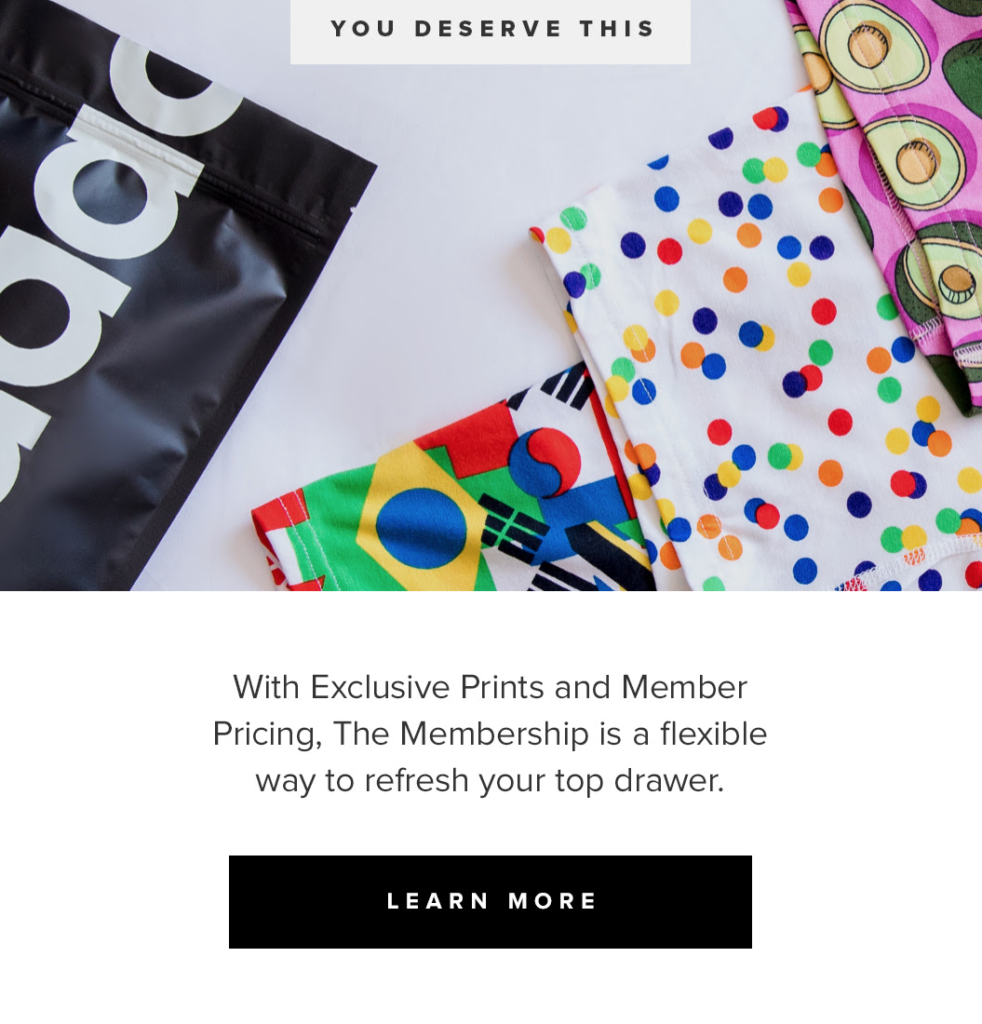
With new (albeit limited) prints available each month, there are endless ways to appeal to subscribers and convert them into repeat buyers.
For instance, while researching this post, MeUndies promoted their brilliantly-titled, “Zero Fox Given” print, targeting an audience segment that identify with not caring what others think.
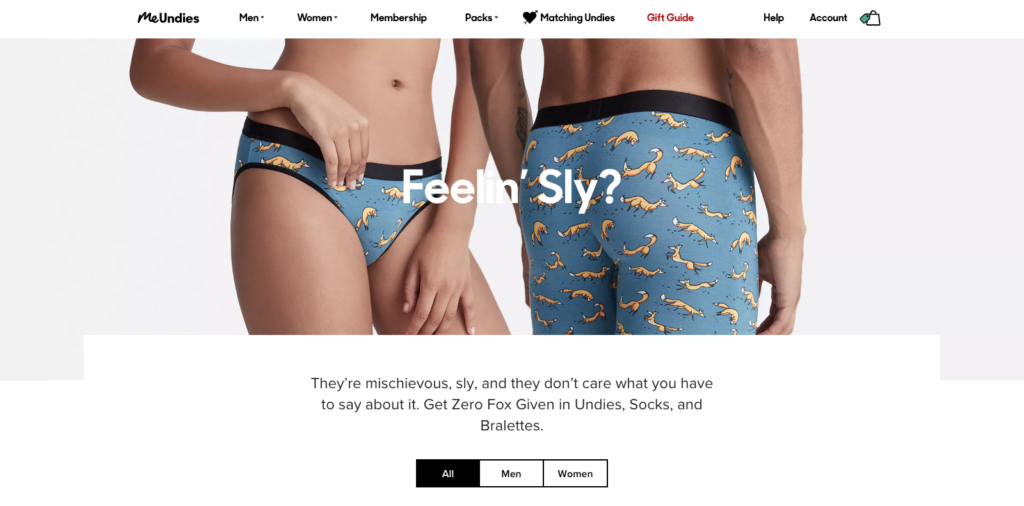
Now, however, they’re promoting their Christmas print, targeting users looking for gifts for the whole family.
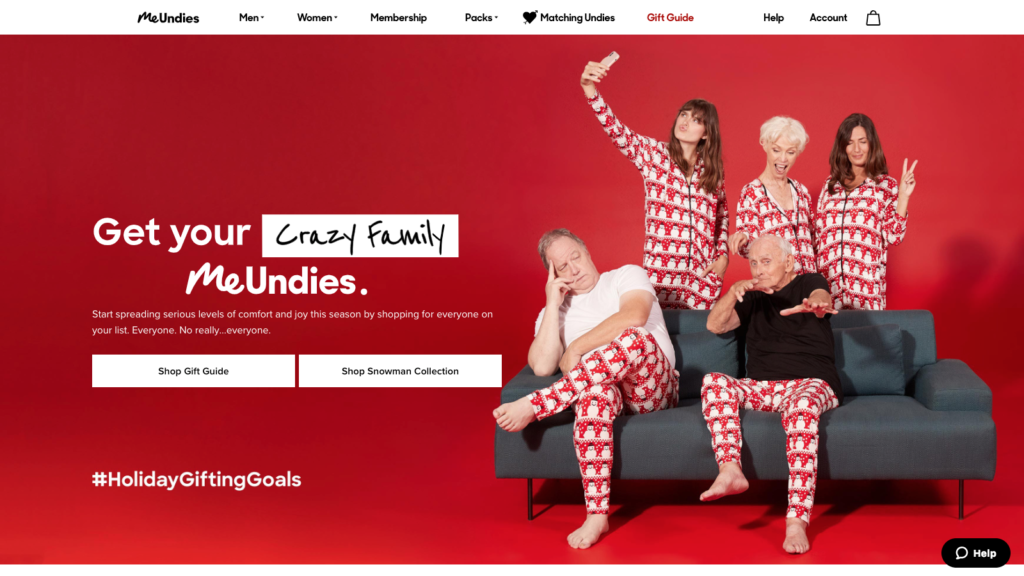
Remember, it only takes ONE angle to convert a subscriber to the membership. And with a constantly evolving collection, and ample marketing angles, it’s only a matter of time.
According to Kennedy, there are four reasons why customers gravitate toward memberships:
- Value propositions. Upgrading makes sense if you’re saving money. Why pay $24 dollars when you can pay $16? (Think: hyperbolic discounting.)
- Exclusive benefits and perks. MeUndies’s exclusive prints are, well, exclusive. And with a limited run each month, they’re highly sought-after.
- Peer influence, “being seen,” recognized, status. MeUndies are big on highlighting members of their “MeUndies Fam” on social media.
- The nature and behavior of the customer. There’s a percentage of people who typically buy the most expensive option. Why? Because that’s how they see themselves. Or, how they want to be seen by others. Buying underwear is no exception.
Action item. Consider offering a membership to increase your customer’s lifetime value. More brands are doing it now. And for good reason: it works. Don’t get left behind.
3. Build a Replicable Referral Engine (with a Twist)
If you read my post on Harry’s Marketing, you know Harry’s got 100,000 email addresses in seven days through referrals.
Not bad.
But as impressive as it is, it’s nothing compared to how MeUndies are getting referrals, consistently, customer by customer.
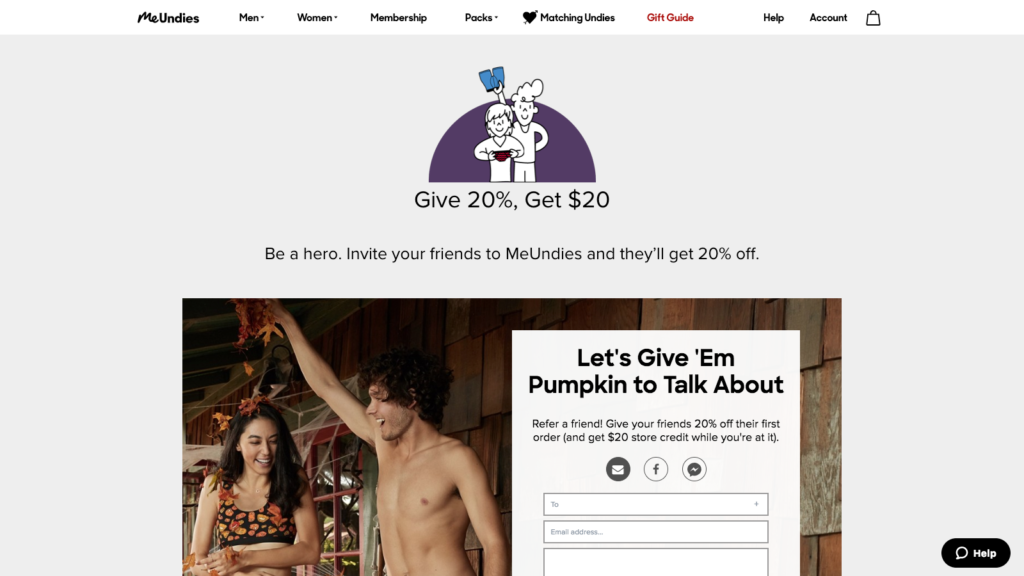
Here’s what they’re doing, element by element.
i. Write a Killer Headline
You know the importance of writing good headlines for your homepage. So, why not have one for your referral program, too?
Rather than writing something generic like “Refer a Friend,” MeUndies emphasize the benefits of their referral program to both parties. The referral gets 20% off their first order; the affiliate gets $20 store credit. (Or, “get free undies”, given that $20 is the average cost of a pair of MeUndies’ underwear.)

ii. Simplify the Referral Process
MeUndies use software called Friendbuy to simplify referring a friend.
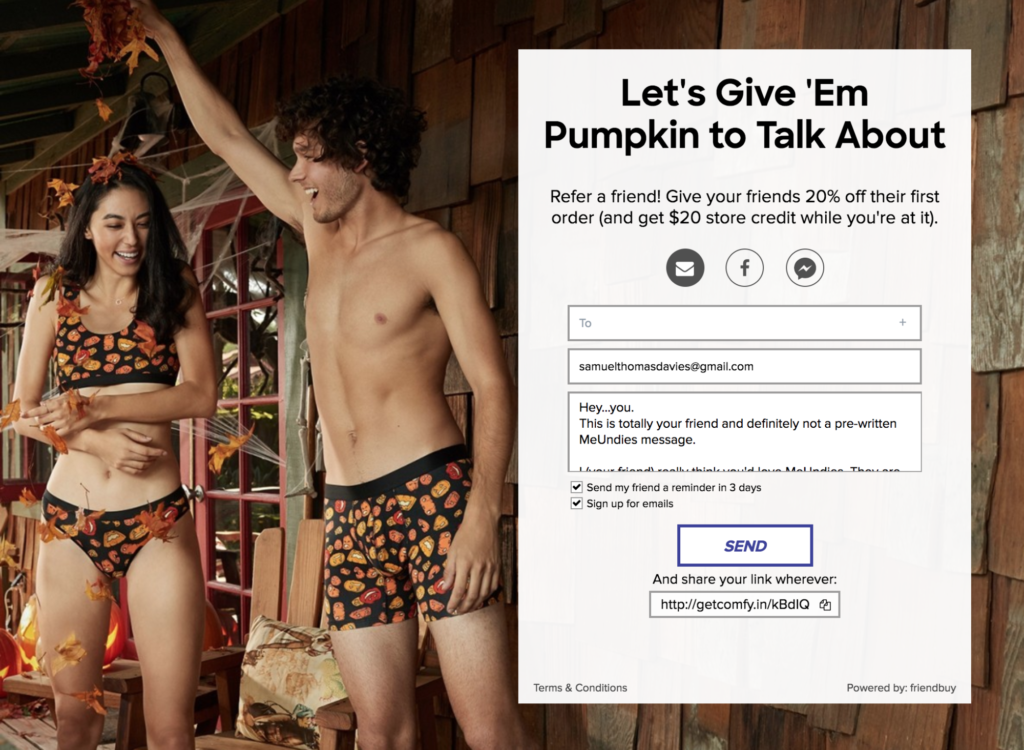
First, they simplify the invitation by offering multiple channels including Facebook messenger and email. Plus, they offer a fun, pre-written template to increase engagement.
Here’s what it says:
Hey…you.
This is totally your friend and definitely not a pre-written MeUndies message.
I (your friend) really think you’d love MeUndies. They are 3x softer than cotton and feature super-fun prints and colors.
Use my referral to get 20% off your first order (excluding packs).
Enjoy!
-Me. Your friend.
They even offer to remind your friend if they don’t reply after three days. (Note: this checkbox is marked by default.)
When the referral receives the email, the affiliate, is cleverly mentioned in the subject line…

…and again in the body copy to explain why the recipient is receiving the email:
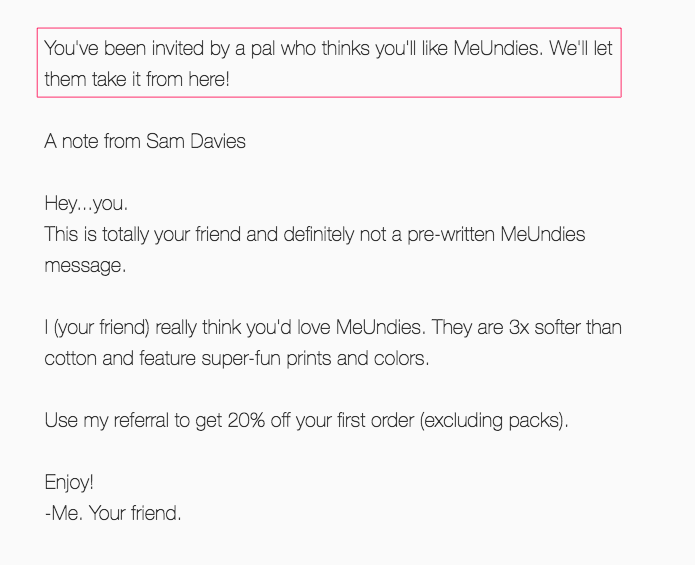
MeUndies use Friendbuy to power their referral emails. So, if you’re looking for a solution, it might be worth checking out.
iii. Focus on the User-Experience…
MeUndies know that buyers are more likely to refer friends after they become customers. With that in mind, they make their referral program more visible on their site to customers. Before I became a customer, their footer optin asked me to join their email list:

And it makes sense, right? After all, they want to convert as many new first-time visitors into leads as possible.
But after a became a customer, their footer optin changed, inviting me to refer a friend:

iv. …And the Post-Purchase Experience
After buying from MeUndies, you get an email inviting you to track your order.
And when you click the link, there’s also a another invitation to refer a friend, if you haven’t done already:
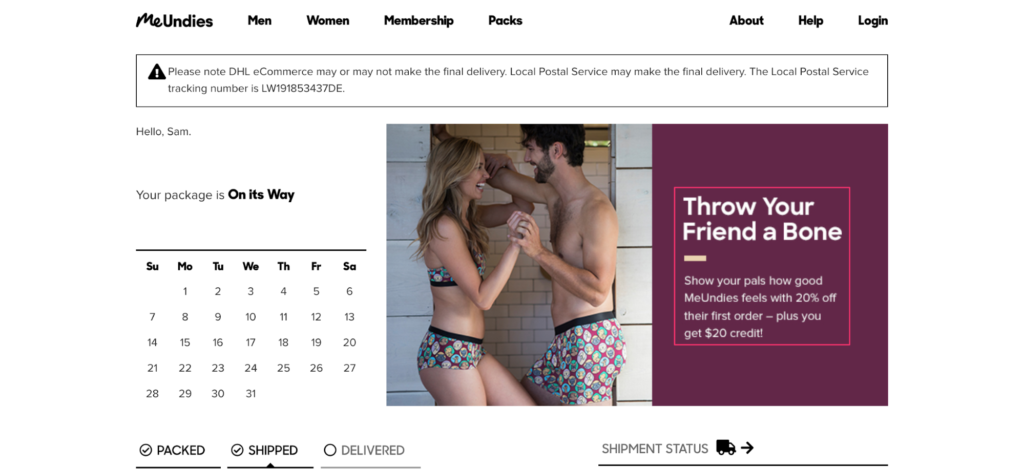
Not everyone will be ready at this stage. I’ll grant you that. But it doesn’t hurt to try.
v. Highlight MVPs
MeUndies regularly highlight a “referrer of the month” on Instagram. When you visit their profile, there’s a link to “Free Undies.”
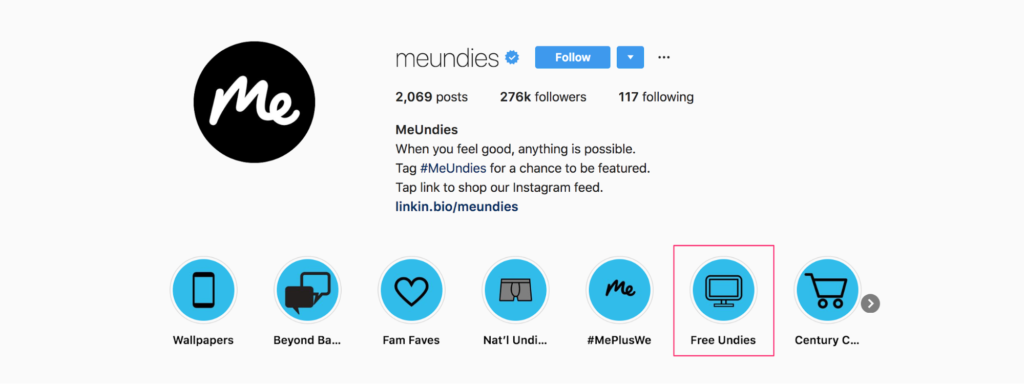
And when you click on it, there’s an Instagram story promoting their referral program, highlighting their current referrer of the month:
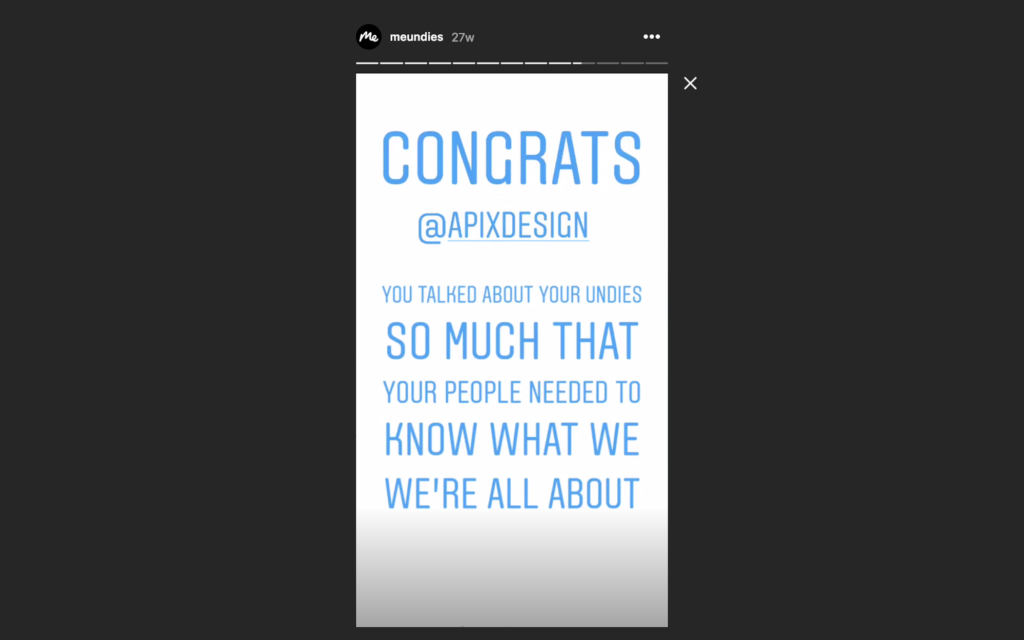
Asking for referrals is key. But, as you would when qualifying leads, timing is everything.
Action item. Invite customers to refer friends using a win-win value proposition and remember to make it super simple to do. Bonus if you can offer a pre-written message.
4.Create a Go-To Gift Guide
As mentioned before, MeUndies get a TON of direct traffic. Meaning, they don’t need to invest in content marketing like other brands.
But that doesn’t mean they don’t venture into it once in a while.
Take their recent Christmas gift guide as an example.
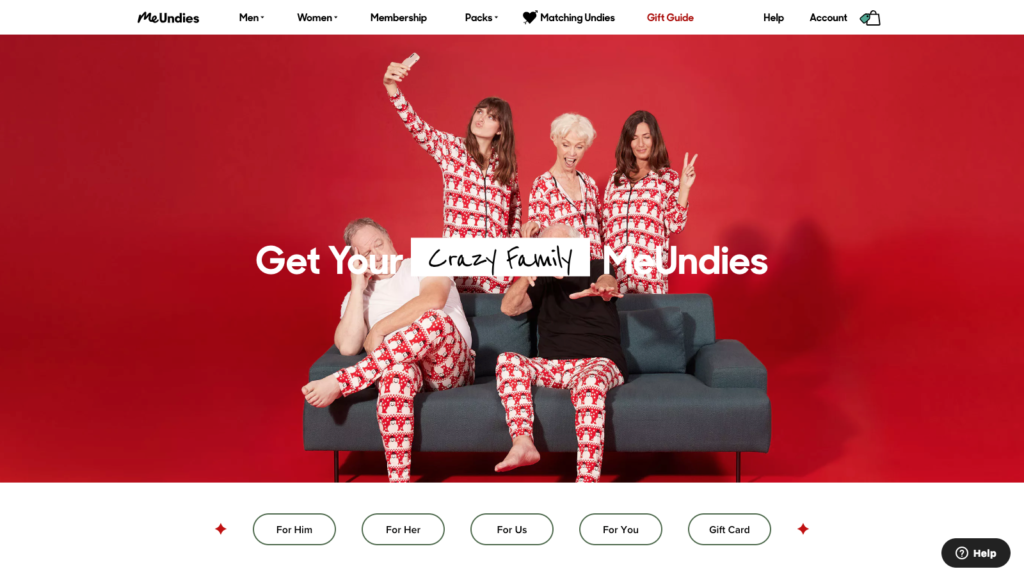
Understanding that few, if any of their customers, know what to buy for their family at Christmas, MeUndies created a go-to guide for all members of the family.
For example, there are sections “for him,” “for her,” and “for us,” appealing to couples.
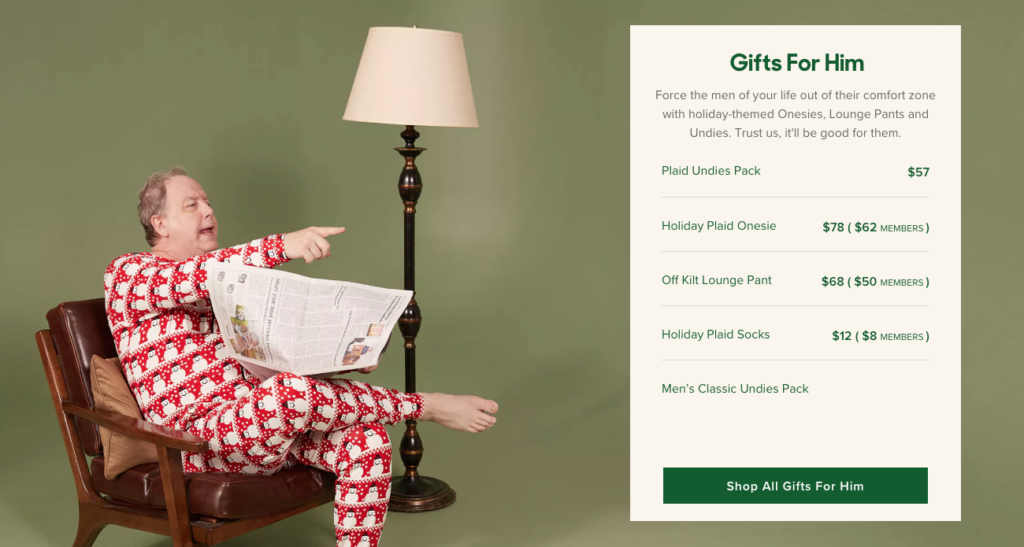
And when you click a section, MeUndies unveil a range of product recommendations, covering several price ranges.
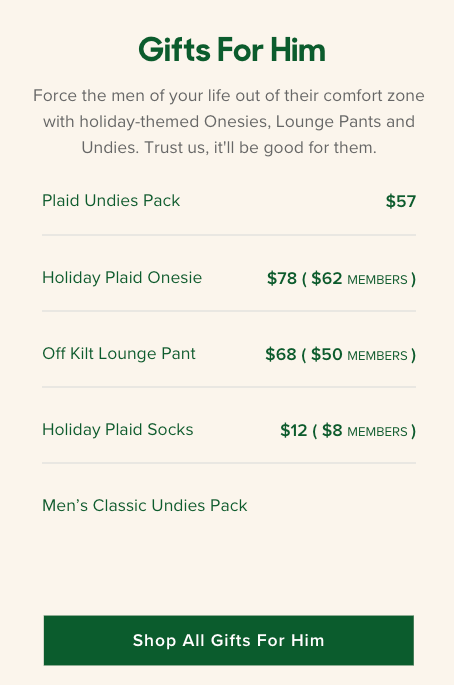
And if you can’t find something?
There’s an option to buy a gift card, instead:
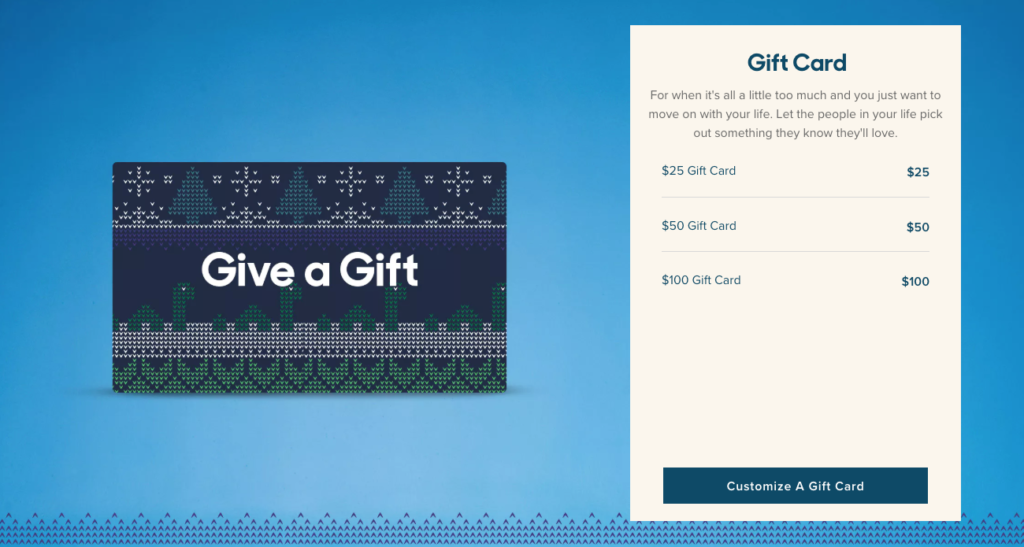
As of writing, MeUndies are promoting it in their emails…
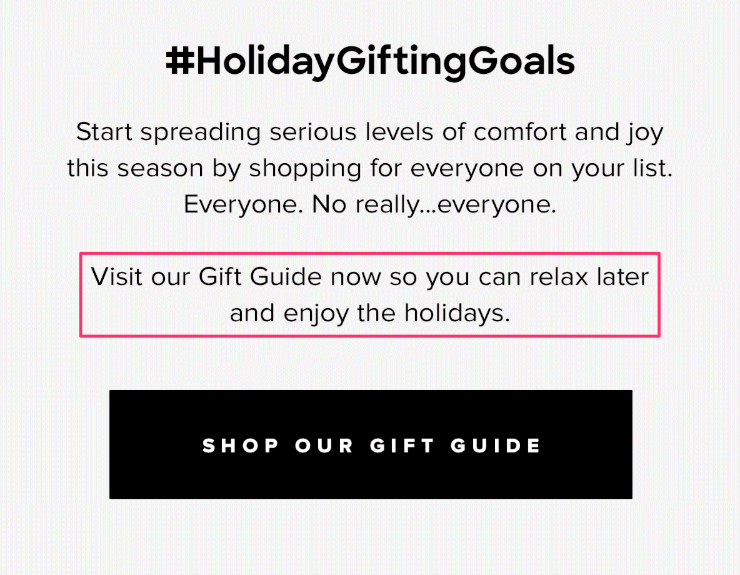
…and their Facebook ads:
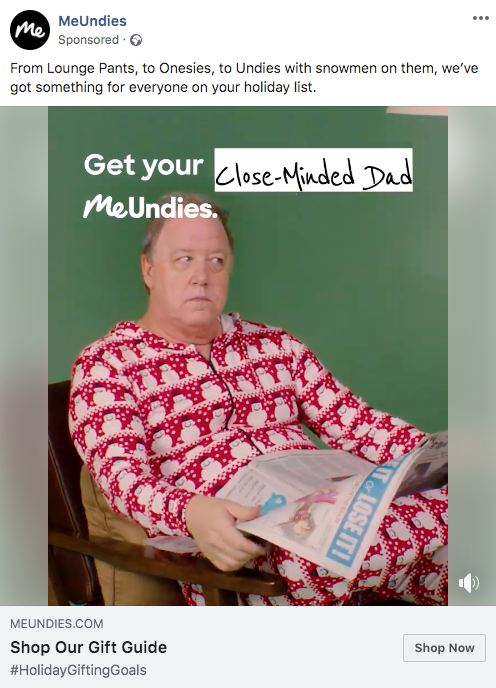
Of course, if they were using an onsite campaign to target return visitors, they could drive more traffic to that page and increase product sales even further.
But that’s not for me to comment on 😉
Action item: If you offer several items under one category such as apparel, create a gift guide, categorized “for him,” “for her,” etc. Perfect for the busy holidays like Black Friday, Christmas, and more.
5. Leverage The Power of Podcasts
If you’re a regular podcast listener, it’s likely you’ve heard of MeUndies.
Why?
Because they’re avid podcast sponsors.
While it’s hard to know exactly how many, we can assume it’s a lot as they currently have as many as 26 landing pages at any one time. (More on that in a moment.):
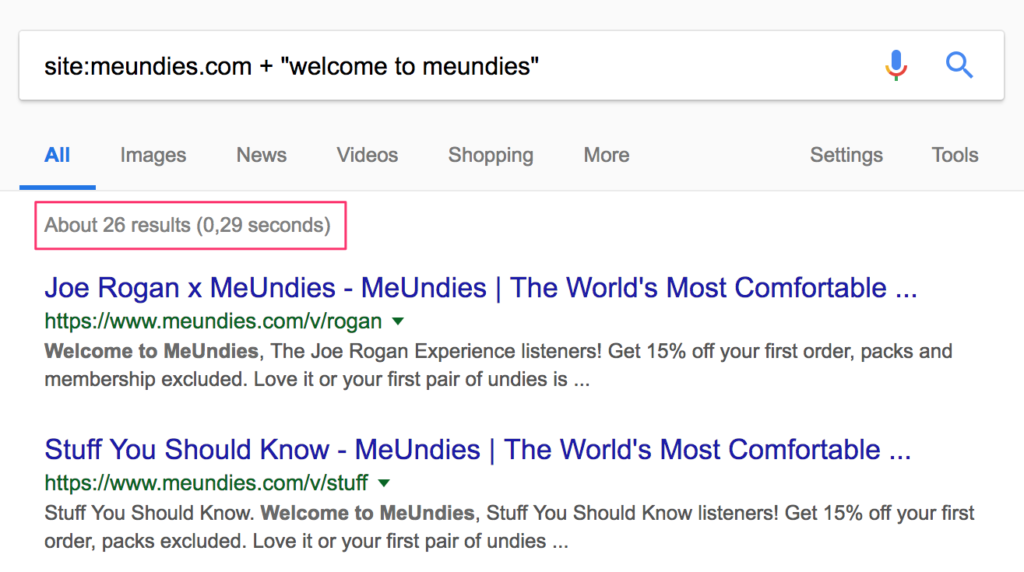
And that’s NOT including podcasts without landing pages. (More on that in a moment, too.)
There’s a good reason for sponsoring podcasts, and it has nothing to do with getting exposure to new audiences:
You get a nice do-follow link from the podcast’s website.
For instance, after sponsoring Nerdist, MeUndies got a link in the episode’s show notes:

But it gets better…
Depending on the podcast, it’s possible to get TWO do-follow links.
Take Satellite Sisters, for example. They host and publish their podcast on Libsyn (90):

But they also syndicate their podcast on Podbean (DR: 89):

One podcast. Two links. #BiWinning
But there’s one more thing I want to highlight, here…
As I’ve mentioned already, MeUndies make it super simple for visitors to buy from them.
One way they do that, at least, with podcast sponsorships, is they create a dedicated landing page for shows they’re sponsoring on an on-going basis.
Take the below page as an example.
MeUndies have a dedicated landing page for visitors coming exclusively from The Joe Rogan Experience.
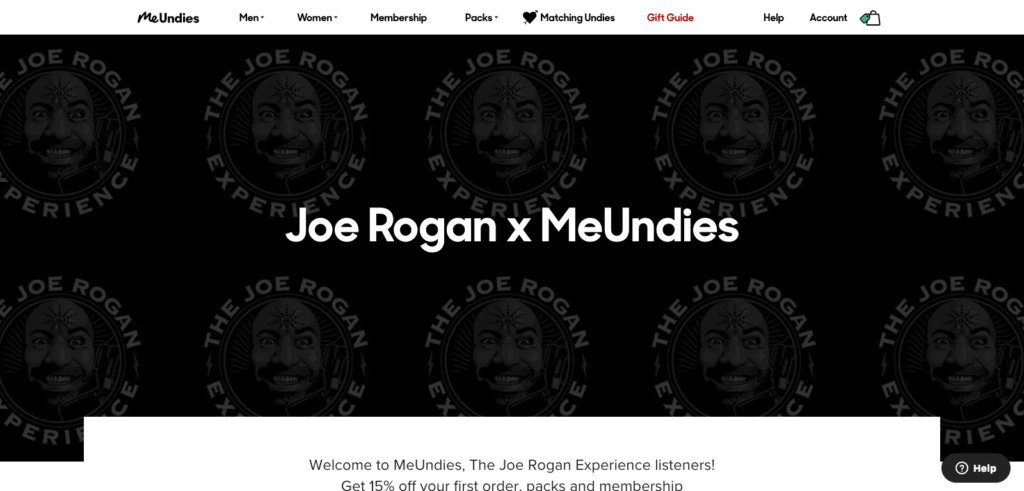
The above-the-fold copy addresses them specifically and emphasizes their irresistible offer and their unbeatable guarantee:

But here’s where it gets interesting…
Rather than give visitors a discount code, they auto-apply it to the user’s checkout, removing a potential barrier to buying.
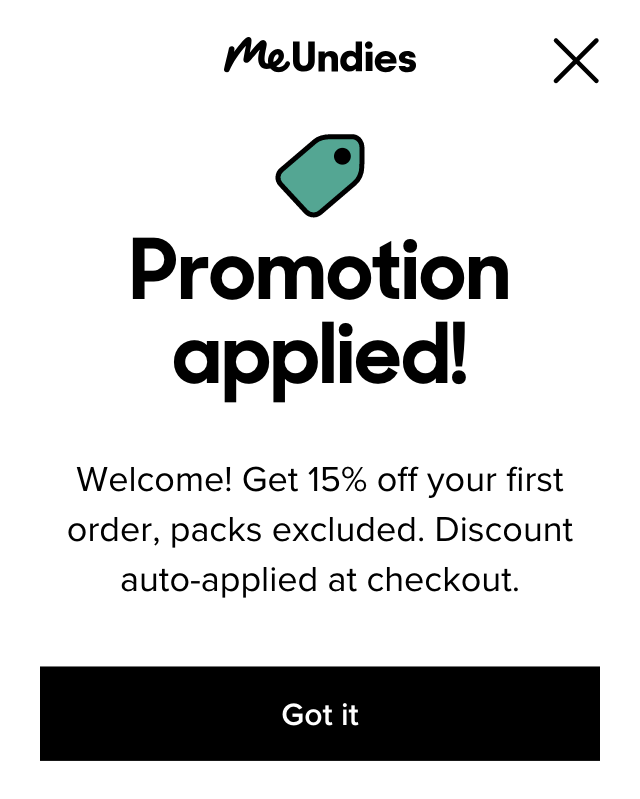
Abandoning checkout in pursuit of a coupon code is a problem for e-tailers. MeUndies know that, so they bypass it entirely.
For the remainder of your visit, MeUndies remind you of your discount, ever-nudging you to make a purchase.
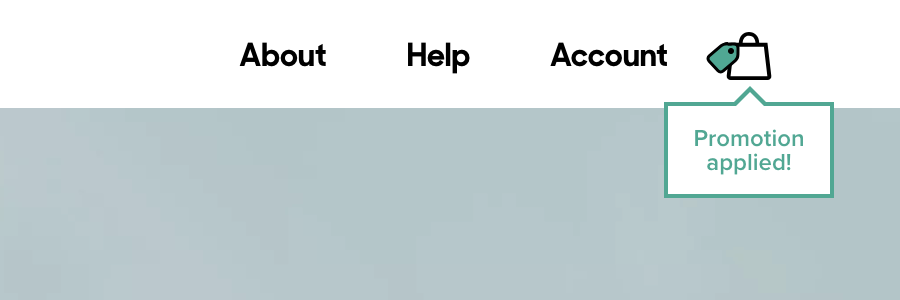
Bottom line?
Sponsoring podcasts is a great way to build links. But sponsoring syndicated podcasts is even better. Choose your sponsors wisely.
Action item. Sponsor podcasts with audiences similar to yours. Then, creating a dedicated landing page to welcome listeners. Finally, offer a discount and, if possible, auto-apply it to their cart.
6. Use The Best-Of Backlink Builder
If you’re a regular reader of our growth guides, you know one of my favorite link building strategies is what I call, “The Best-Of Backlink Builder.”
If you need a refresher, The Best-Of Backlink Builder involves reaching out to authority domains in your industry and getting featured in best-of content.
For example, if you sell women’s yoga pants, you might search for “best yoga pants for women 2018” and try to get featured in one of the top search results:
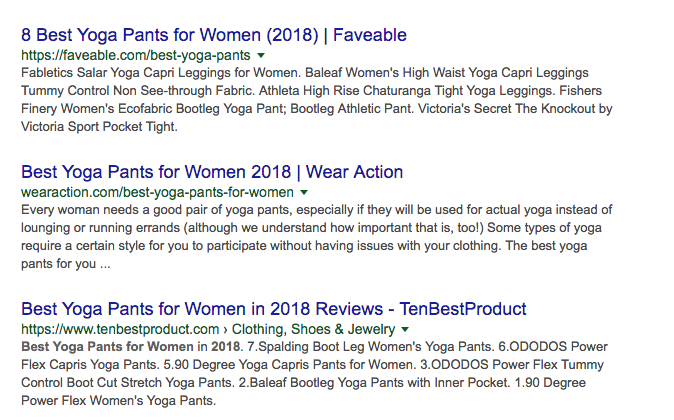
Yes, it requires work. But over time, you become omnipresent … and it becomes a LOT easier to build links.
Just ask MeUndies.
One of their best backlinks, in terms of domain rating, comes from The Huffington Post in their article, “10 Men’s Clothing Subscription Boxes Every Guy Should Try.”
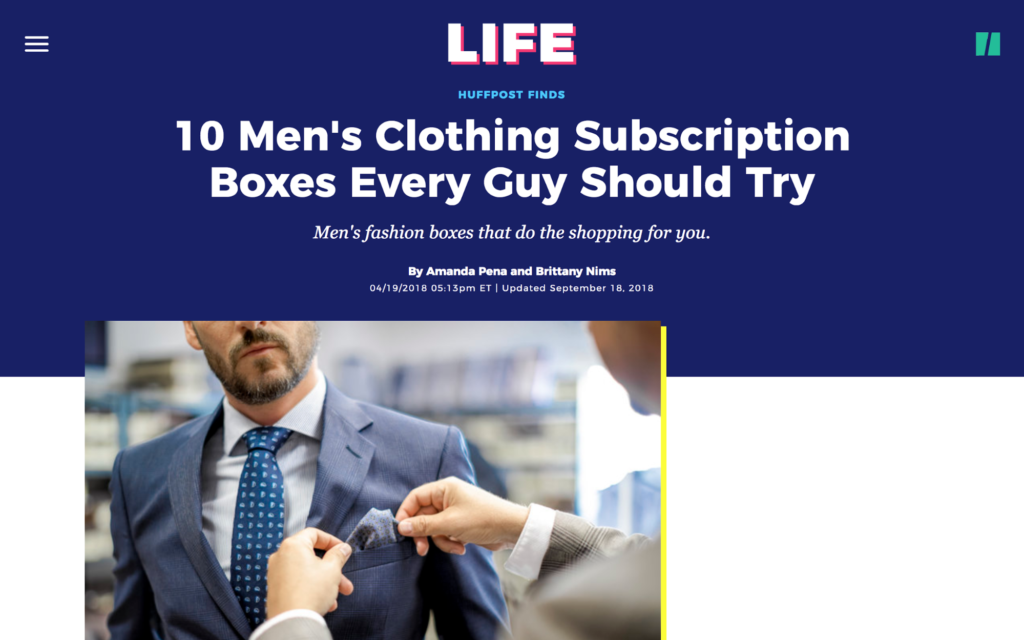
But it’s not just for authority sites.
Here’s a recent link from a smaller site, The Pearl Source (DR:57):
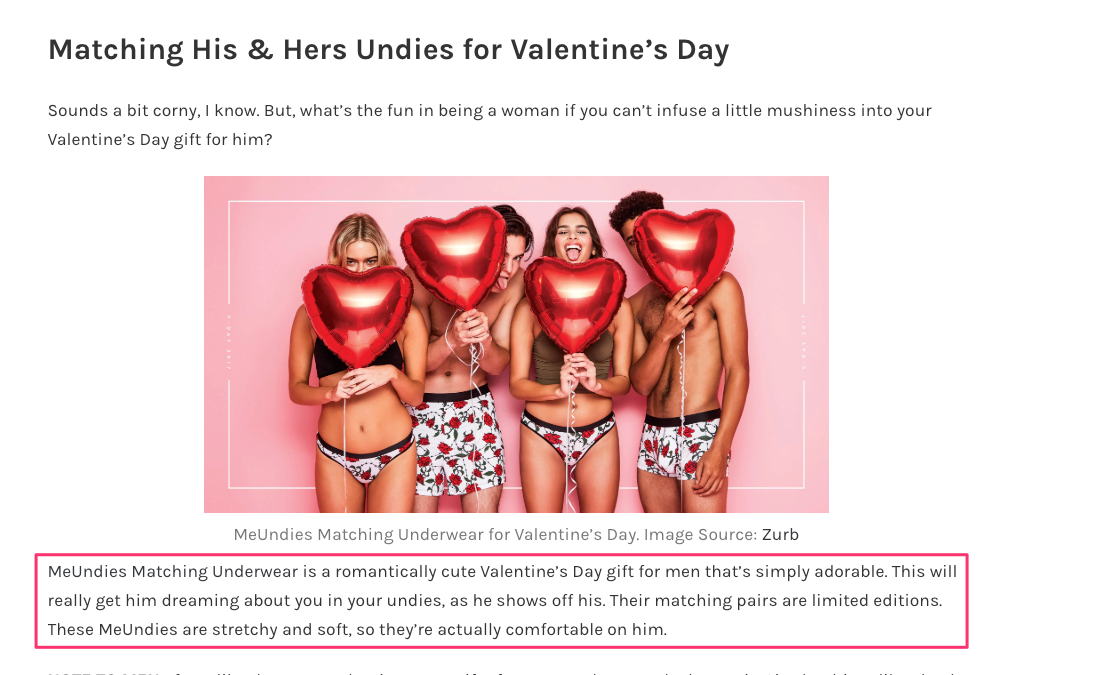 Best of all, by scaling this strategy, MeUndies are now ranking for some highly-competitive commercial keywords.
Best of all, by scaling this strategy, MeUndies are now ranking for some highly-competitive commercial keywords.
Take, “boxer briefs” as an example.
As of writing, MeUndies rank #2—above Amazon:
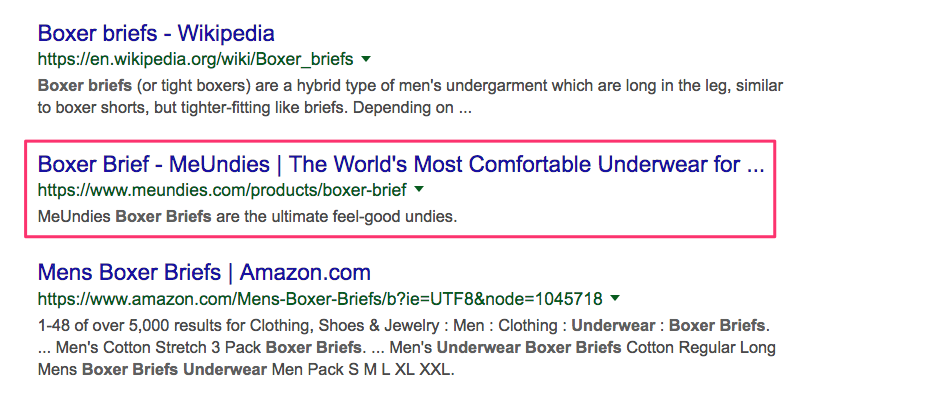
And when you look at their backlink profile, it’s not hard to see why.
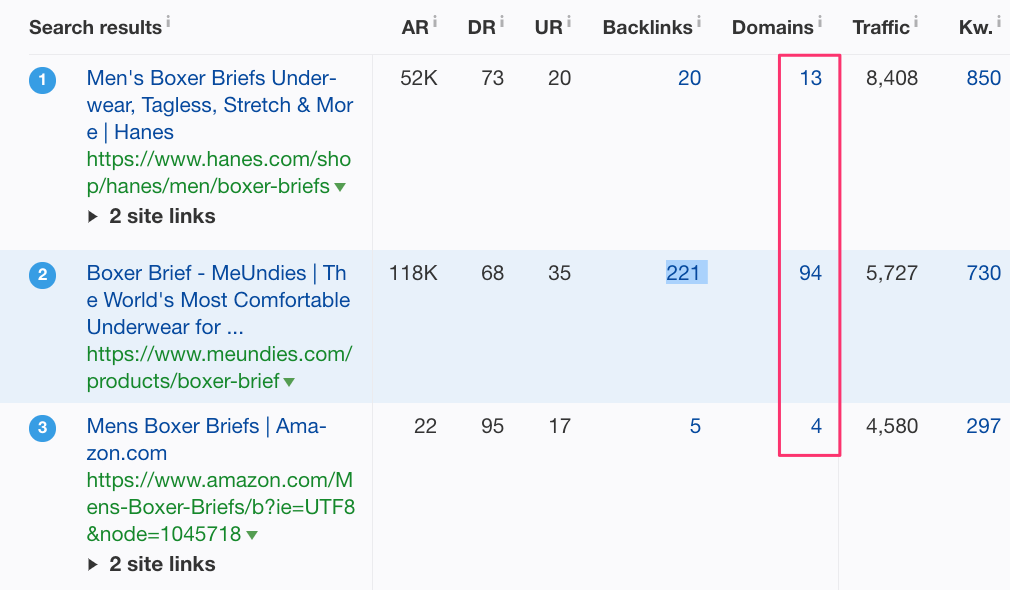
MeUndies have ninety-four backlinks compared to Amazon’s four and Hane’s 13.
And it’s interesting because if you take a closer look, you can see several of those 94 links are from, you guessed it, best-of articles.
Here’s one from HelloGiggles:
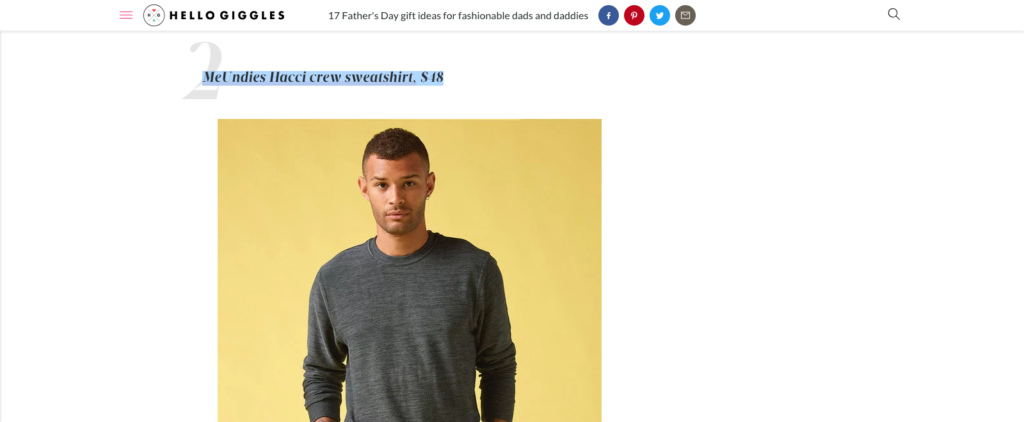
And another from Dodo Burd:

Think of your biggest competitor. Now think about outranking them. Doesn’t seem as hard now, huh?
Action item: Build links from best-of content. Bonus if you build them to uber-competitive product pages. Who knows, you might just outrank Amazon.
7. Activate New Subscribers with Small Wins
Not everyone is ready to buy from you.
That’s a given.
I know that. You know that. And MeUndies certainly know that (judging from their remarketing.)
But that doesn’t mean you can’t pitch something in your onboarding emails.
Take a recent experience as an example.
After I joined their newsletter, but before I became a customer, I got an email with the subject line “7 Million Happy Butts and Going Strong.” In it, was an invite to join the “MeUndies Fam” by following MeUndies on social media.
Here’s an excerpt:
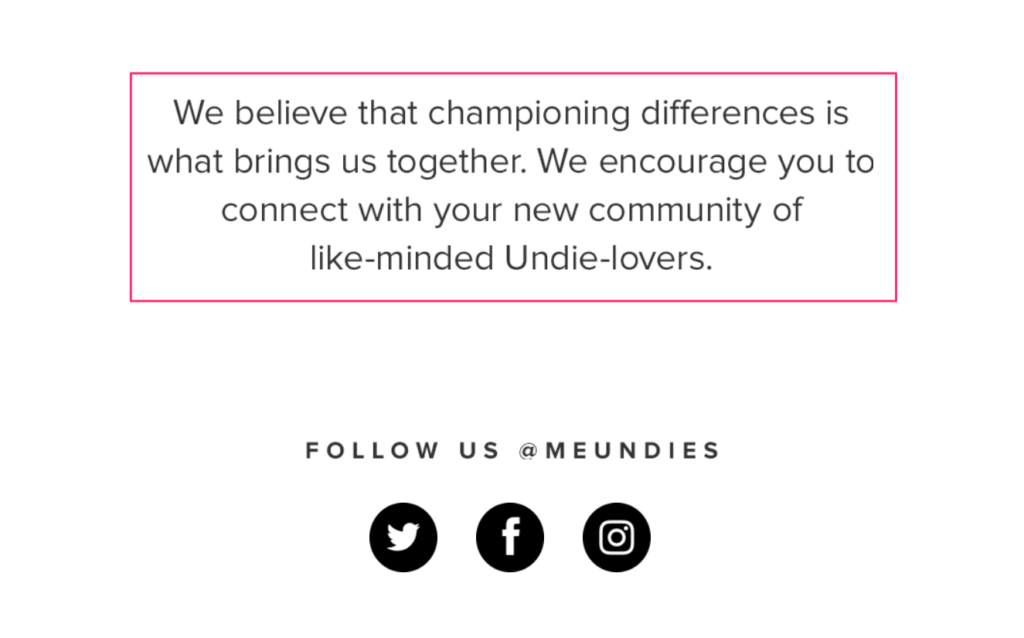
There’s a good reason for sending an email like the above:
It’s a great way to activate new subscribers.
Why?
Because people tend to behave in ways that are consistent with an earlier action.
In other words, when someone complies with a small request—like following a social media profile—they’re more likely to comply with a similar or larger request later (like buying something).
This is known as commitment and consistency…
…and it’s one of the best persuasion triggers in marketing.
Granted, it won’t guarantee more customers, but it won’t hurt your chances, either.
Action item. Activate new subscribers by inviting them to something other than buying something. Ask yourself, “What’s a small request I can make?” Then, ask them to do it.
8. Persuasion Triggers + Cart Recovery Emails = More Sales
If you’re an e-tailer, you know the importance of sending cart recovery emails.
I won’t repeat anything you already know here.
But what I will do, is show you a clever way MeUndies are using persuasion triggers in their cart recovery emails.
For example, while writing this post, I abandoned my cart. And a few hours later, I got a cart recovery email.
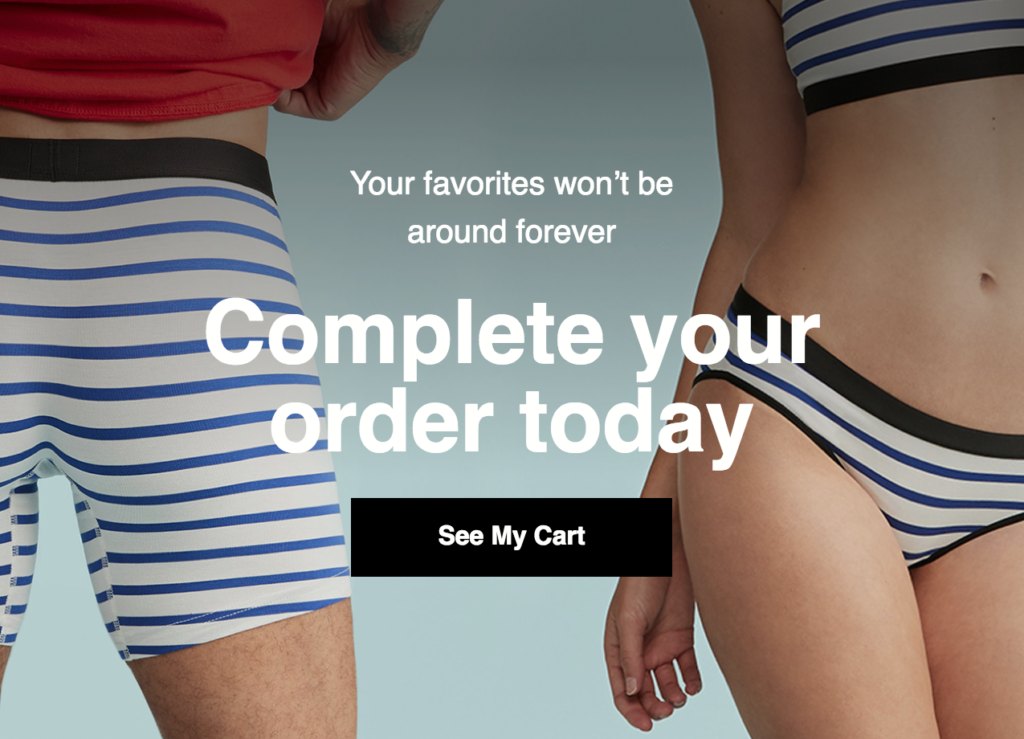
Nothing new there. We all know scarcity is the bedrock of e-commerce email marketing.
But here’s where they differentiate themselves…
A day later, I got another email, only this time, MeUndies informed me that my cart had expired:
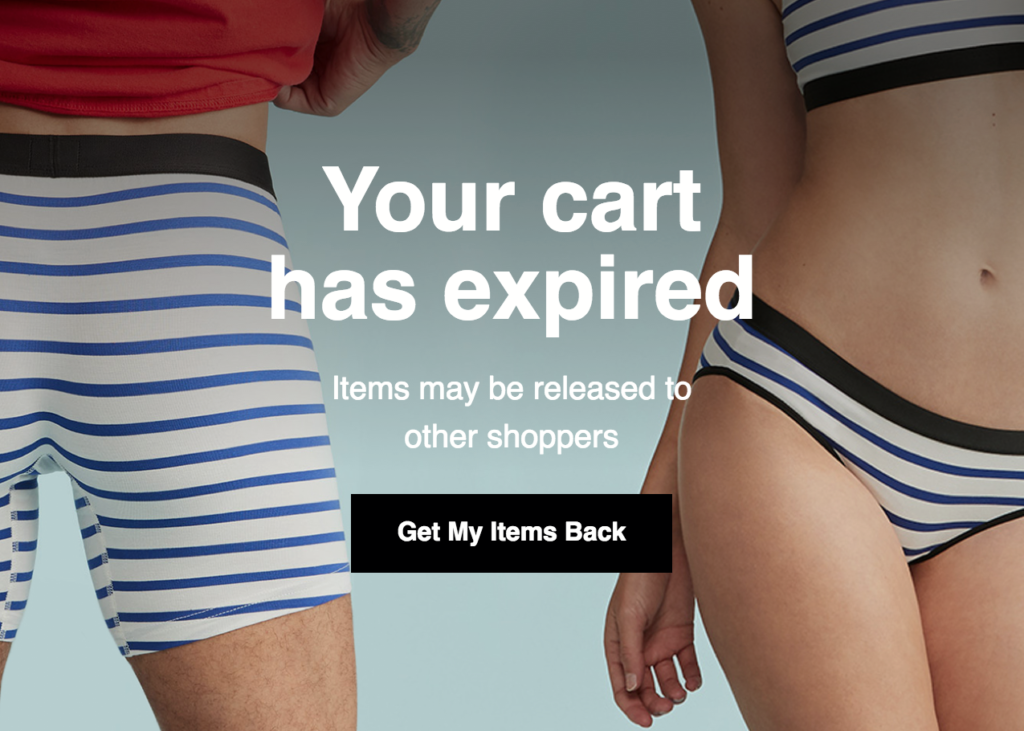
In two emails, I went from fear of missing out (“Your favorites won’t be around forever”) to ACTUALLY missing out (“Your cart has expired”).
Of course, I hadn’t really missed out—my item was still available. But I FELT like I had. And clicking “Get My Items Back” was enough to give me the extra nudge I need to buy. (Yes, like many shoppers, I’m a sucker for loss aversion.)
Another trigger MeUndies take is incentivizing order completion with a coupon. In other words, triggering implied urgency.
After abandoning my cart, on another occasion, I got the following email:
.png?width=639&height=460&name=MeUndies%20Cart%20Recovery%20Email(1).png) Everyone loves discounts. And if it’s for an item you showed interest in, and the coupon is a surprise, it, too, can be enough to convert on-the-fence buyers.
Everyone loves discounts. And if it’s for an item you showed interest in, and the coupon is a surprise, it, too, can be enough to convert on-the-fence buyers.
And if that wasn’t enough, they also linked to similar products, in case I changed your mind since you last shopped.
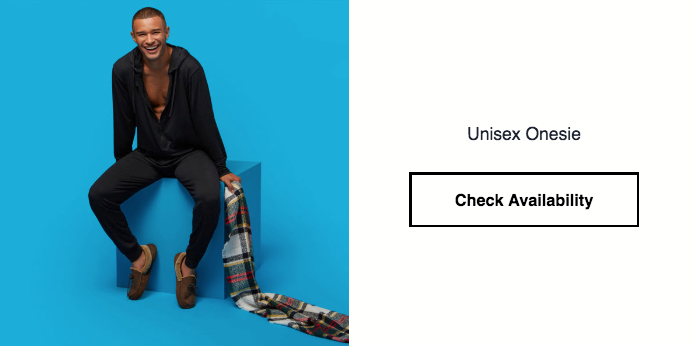
It’s the little things that make a big difference. Don’t overlook them.
Action item: It’s not enough to remind shoppers what they’ve left in their cart; you need to remind them what they’ll LOSE (even if it’s time needing to re-add their items). Tell dawdling buyers what they’re about to LOSE. Then, what they’ve LOST, before telling them how to get their items back. Targeting consumer psychology goes a long way.
9. Ask for Feedback to Improve Your Product
You know the importance of asking for feedback. With the right data, you can do more of what works and ruthlessly eliminate what doesn’t.
But are you asking the right questions at the right time?
While writing this article, I became a MeUndies customer. And a few days after my order arrived, I got the following email.
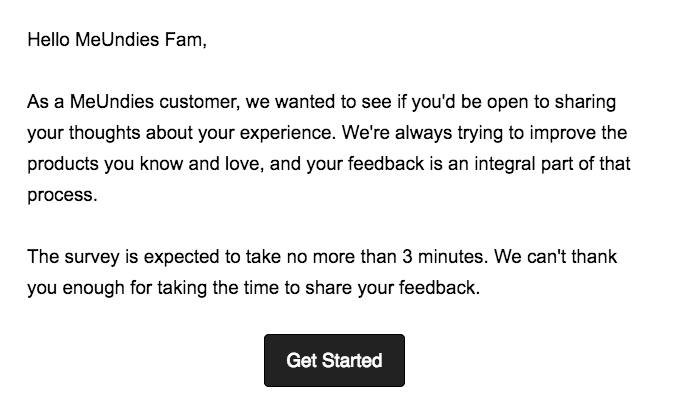
When I clicked the link, MeUndies redirected me to a survey asking me about my experience:
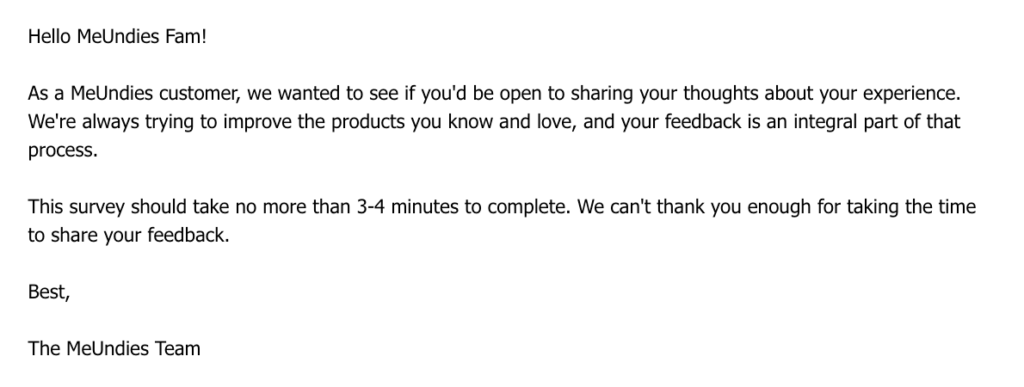
They asked me the usual questions you would expect from a survey—my age, my gender, my ethnicity, etc.
But, like any good survey, they also vary their questions depending on what you bought.
For instance, if you bought an item for someone else, you bypass questions like the one below:
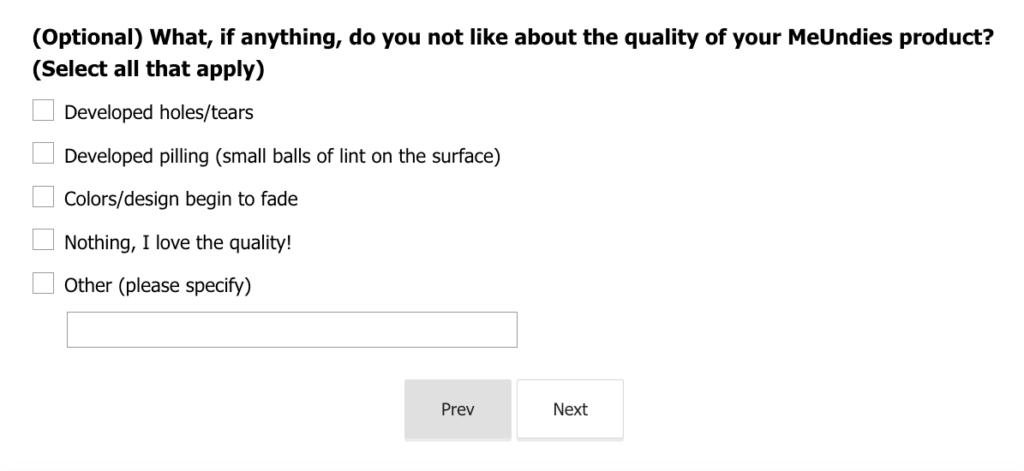
Asking closed questions offers MeUndies more specific answers—giving them more quantitative and qualitative data to improve their product line.
Here’s a great example of one question doing that:
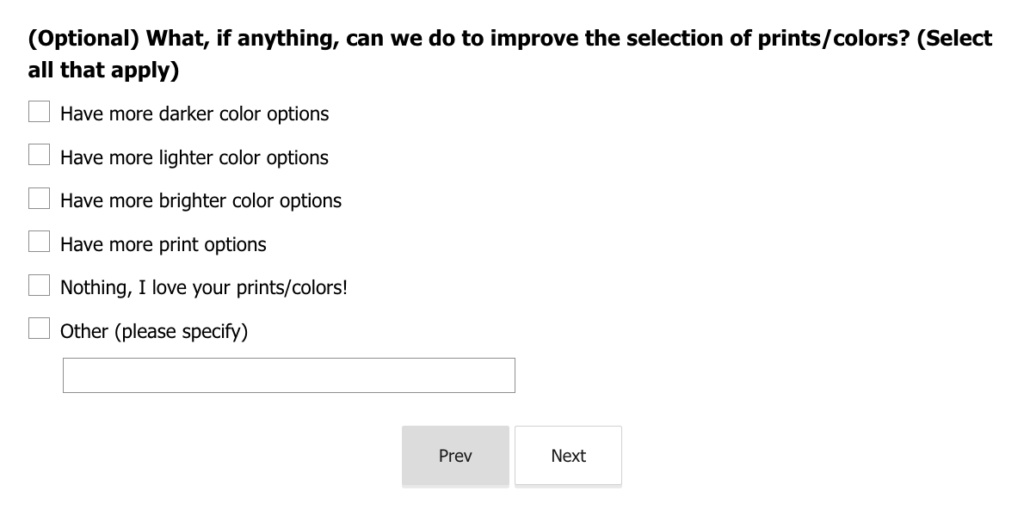
Interestingly, a week later, I got another email asking how strongly I would recommend a friend.
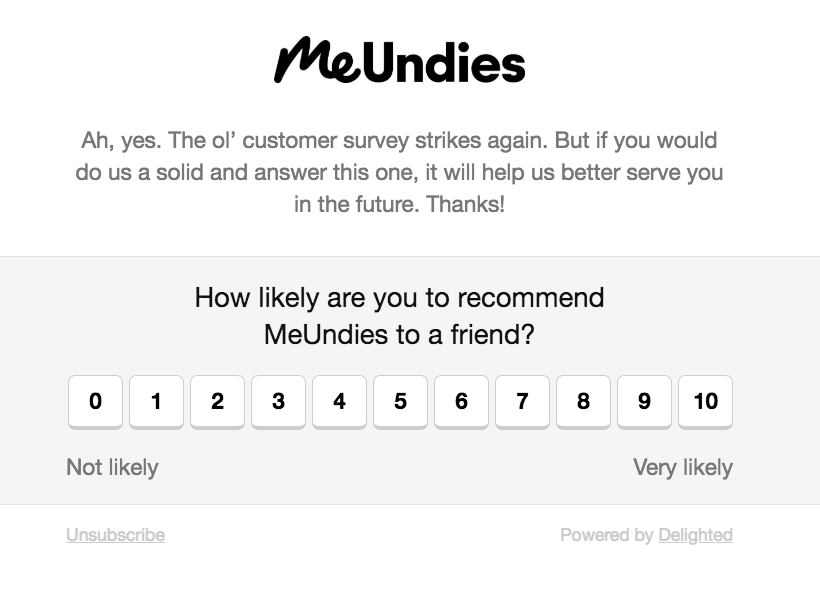
“Why would they send another email asking for feedback?”
I thought that, too.
And I pondered on it. A LOT.
That is until I looked further, and assume it’s to improve their net promoter score.
You see, in the previous email, they survey customers using SurveyMonkey. It’s important information, but it’s hard to extrapolate from the rest of the data. But in the above email, they use a software called Delighted, giving them immediate feedback in one place:
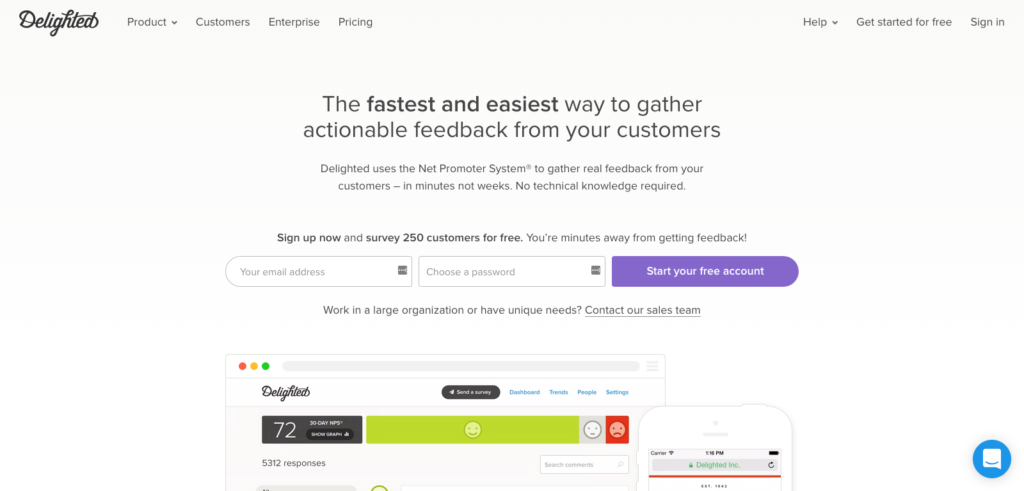
Of course, it’s also an opportunity to reach out again to customers that didn’t take or even complete the survey, giving them the feedback they need to improve their product.
Action item: Ask customers for feedback. Then, reach out once more with the single most important question. Not everyone will complete the first, but if the follow up is easier to complete, it’s more likely you’ll get responses.
Conclusion
So, there you have it: MeUndies’s marketing strategies in 3,500 words.
Here’s a refresher of their strategies once more:
- Strategy #1: Turn Visitors into Buyers with a Homepage Quiz
- Strategy #2: Create an Ascension Ladder to Increase Retention
- Strategy #3: Build a Replicable Referral Engine (With a Twist)
- Strategy #4: Create a Go-To Gift Guide
- Strategy #5: Leverage The Power of Podcasts
- Strategy #6: Use The Best-Of Backlink Builder
- Strategy #7: Activate New Subscribers with Small Wins
- Strategy #8: Persuasion Triggers + Cart Recovery Emails = More Sales
- Strategy #9: Ask for Feedback to Improve Your Product

